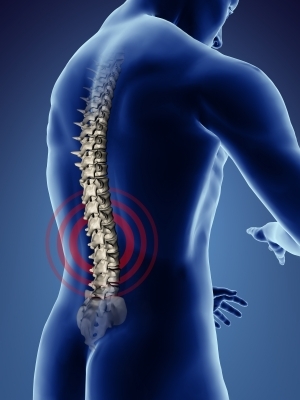By Dr. Vivian Ebert


It controls the muscles of the lower leg and provides sensation to the thighs, legs, and the soles of the feet. Although sciatica is a relatively common form of low-back and leg pain, the true meaning of the term is often misunderstood.
Sciatica is actually a set of symptoms – not a diagnosis for what is irritating the nerve root and causing the pain. Sciatica occurs most frequently in people between the ages of 30 and 50 years old. Most often, it tends to develop as a result of general wear and tear on the structures of the lower spine, not as a result of injury.
What are the symptoms of sciatica?
The most common symptom associated with sciatica is pain that radiates along the path of the sciatic nerve, from the lower back and down one leg; however, the symptoms can vary widely depending on where the sciatic nerve is affected. Some may experience a mild tingling, a dull ache, or even a burning sensation, typically on one side of the body. Some patients also report:
- A pins-and-needles sensation, most often in the toes or foot.
- Numbness or muscle weakness in the affected leg or foot. Pain from sciatica often begins slowly, gradually intensifying over time. In addition, the pain can worsen after prolonged sitting, sneezing, coughing, bending, or other sudden movements.
What causes sciatica?
The most common cause of sciatica is irritation of the sciatic nerve in the lower back (lumbar region) due to a herniated or ruptured disc. Spinal discs are shock-absorbing cushions between each vertebra that keep your spine flexible. Discs have a stronger outer ring and a soft jelly-like center, but as we age, spinal discs can deteriorate, becoming drier, flatter, and more brittle. Frequently, the tough outer covering may develop tiny tears, which allow the jelly-like substance to seep out (rupture or herniate).
The herniated disc may then press on the nerve root, causing sciatic symptoms such as pain, tingling, and weakness in the legs and feet.
Nerve roots may also be irritated by the chemicals found in the discs’ nucleus. Other conditions can also put pressure on the nerve, including:
- Spinal stenosis – narrowing of the spinal canal, which places pressure on the spinal cord or the nerve roots.
- Degenerative disc disease – a common part of the aging process, leading to a change in the disc shape and function, which can result in disc herniation or pain.
- Pregnancy – extra weight and pressure on the spine can compress the sciatic nerve.
- Trauma – a fall, car accident, or other trauma can injure the nerve roots.
- Piriformis syndrome – spasm of the piriformis muscle can compress the sciatic nerve.
- Spondylolisthesis – when a vertebra slips forward over another vertebra, the slip can pinch the nerve root.
- Spinal tumors or infections – very rare; both can compress the sciatic nerve.
In rare cases, a herniated disc may press on nerves that cause you to lose control of bladder or bowel functions. This is an emergency situation and requires an immediate call to your doctor.
How is sciatica diagnosed?
Your doctor of chiropractic will begin by taking a complete patient history. You’ll be asked to describe your pain and to explain when the pain began, and what activities lessen or intensify the pain. Forming a diagnosis will also require a physical and neurological exam, in which the doctor will pay specific attention to your spine and legs. You may be asked to perform some basic activities that will test your sensory and muscle strength, as well as your reflexes. For example, you may be asked to lie on an examination table and lift your legs straight in the air, one at a time.
In some cases, your doctor of chiropractic may recommend diagnostic imaging, such as x-ray, MRI, or CT scan. Diagnostic imaging may be used to rule out a more serious condition, such as a tumor or infection, and can be used when patients with severe symptoms fail to respond to six to eight weeks of conservative treatment.
What are my treatment options?
For most people, sciatica responds very well to conservative care, including chiropractic. Keeping in mind that sciatica is a symptom and not a stand-alone medical condition, treatment plans will often vary depending on the underlying cause of the problem.
Chiropractic offers a non-invasive (non-surgi-cal), drug-free treatment option. The goal of chiropractic care is to restore spinal movement, thereby improving function while decreasing pain and inflammation. Depending on the cause of the sciatica, a chiropractic treatment plan may cover several different treatment methods, including but not limited to spinal adjustments, ice/heat therapy, ultrasound, TENS, and rehabilitative exercises.
Chiropractic spinal manipulation is proven to be effective and has minimal side effects. Recently released practice guidelines published in the Annals of Internal Medicine (2007) stress a conservative approach to treating low-back pain and recommended spinal manipulation as one treatment with proven benefits. Unless advised otherwise by your doctor of chiropractic, remain active and avoid prolonged bed rest.
In the long run, inactivity can make your symptoms worse, whereas regular exercise has been shown to reduce the intensity of pain associated with sciatica. Fortunately, 80 to 90 percent of patients with sciatica will recover without surgery. If surgery is warranted or your doctor of chiropractic feels it would be best to co-manage your condition with another provider, however, he or she will refer you to a local specialist.
LivingWell Chiropractic
 Southwest Florida's Health and Wellness Magazine Health and Wellness Articles
Southwest Florida's Health and Wellness Magazine Health and Wellness Articles
